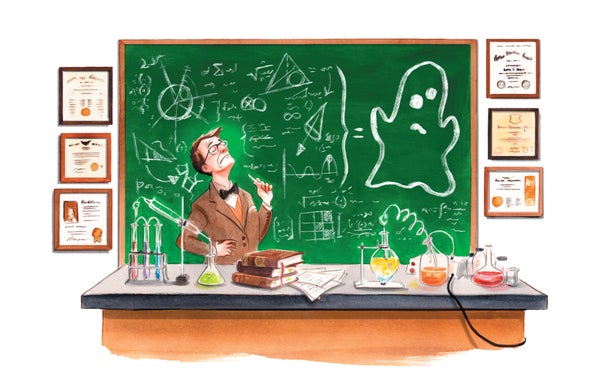[ad_1]
In matters of scientific debate, follow the Houdini rule
Scientific experience is usually limited and specific. When evaluating scientific claims, consult relevant experts.

In the late 19th and early 20th centuries, prominent scientists around the world believed that paranormal The activity could be detected and demonstrated by scientific methods. The history of his attempts tells us something important about the limits and specificity of scientific experience.
The Society for Psychical Research was founded in the United Kingdom in 1882 to investigate possible paranormal activity, including mesmerism, thought transference, apparitions, and even haunted houses. Prominent members included the economist Henry Sidgwick, the physicist Oliver Lodge (a pioneer in the study of electromagnetism), and the writer Arthur Conan Doyle. These men sought to study the subject in a scientific way, “without prejudices or pretensions of any kind.” Other well-known scientists who attended the sessions included Harvard University psychologist and philosopher William James (one of the founders of a philosophical school known as pragmatism) and British biologist Alfred Russel Wallace (who, along with Charles Darwin, developed the theory of evolution by nature). selection).
The mainstream media reported on these efforts, often uncritically. “The soul has weight, the doctor thinks,” declared a New York Times headline on March 11, 1907. With four medical colleagues as witnesses, “reputable physician” Duncan MacDougall of Massachusetts had placed the body of a dying man in a specially designed bed, with built-in scale, next to an empty but otherwise identical bed . At the time of the man’s death, the scale reportedly moved, indicating a weight loss in his side of about an ounce. Five other cases showed losses between one ounce and half an ounce. In the case of a large and “phlegmatic” man, weight loss was delayed by one minute; MacDougall concluded that the deceased’s lazy nature led his soul to depart without alacrity. (Wikipedia suggests that this experiment is the source of the popular notion that the human soul weighs 21 grams.)
About supporting scientific journalism
If you are enjoying this article, please consider supporting our award-winning journalism by subscribing. By purchasing a subscription, you help ensure the future of impactful stories about the discoveries and ideas that shape our world today.
He Times It similarly informed the work of Charles Henry, professor of mathematics at the Sorbonne in France. “The soul can be measured, maintains a mathematician,” a headline announced on September 20, 1925. The evidence here consisted of radiating “biological vibration,” which occurred when death disturbed the delicate balance of life. This observation marked “the first time that science has admitted that tangible evidence for the existence of the soul can be found,” the article stated, insisting that the professor was neither a “psychic nor a dreamer,” but a scientist who had taken advantage of “all the information”. available on colored auras and memories of previous existences that until now have been exploited almost exclusively by cranks.”
These stories remind us that a scientist’s opinions are not necessarily equivalent to “science.” MacDougall and Henry might have believed they had proven the existence of the soul, but most of their contemporaries did not. An obvious problem was that these experiments assumed the existence of what they were trying to prove: essentially a circular argument.
The history of psychic research also shows why we should take new scientific claims with caution, especially those that would fulfill one of our most cherished desires, such as communicating with our lost loved ones or enjoying eternal life. What seems plausible today – even at Harvard and the Sorbonne – may seem absurd in the future.
Perhaps the most important lesson, however, especially in our current environment saturated with disinformation and disinformation— refers to the specificity of scientific expertise: scientists are specialists and their training rarely prepares them to evaluate claims beyond their particular areas of focus.
What experience, exactly, would be needed to evaluate claims of the supernatural or paranormal? Another account from the annals of psychic research helps answer that question. Is he history of the Boston medium Mina Crandon, popularly known as “Margery.”
In 1922 American scientist announced the creation of an awards committee to investigate psychic claims, promising $5,000 to anyone who could prove the reality of the paranormal or supernatural activity. Margery had been put forward as a candidate. Her review committee included Harvard psychologist and Royal Society Fellow William McDougall; Massachusetts Institute of Technology physicist Daniel F. Comstock (who later helped develop the Technicolor process for making color films); and world-renowned magician and escape artist Harry Houdini. Although the historical facts are somewhat disputed, it appears that the committee was inclined to award the prize to Margery until Houdini identified her techniques for the tricks they were. He was a magician, not a physicist or a mathematician, who had the experience to recognize the sleight of hand of the supposed medium.
Nowadays all kinds of people make scientific claims, often with little or no experience in the subject in question. Some are scientists who drive outside their lane. The American physicist and inventor William Shockley, who shared the 1956 Nobel Prize in Physics for the creation of the transistor, used his stature to promote racism and eugenics.
Physical John F. Clauser2022 Nobel Prize winner who was honored for his contributions to quantum information science, is a self-proclaimed climate changer.”denier” who has been taking to podiums around the world to argue against the scientific consensus that the planet is experiencing dangerous warming. Several celebrities have falsely claimed that vaccines cause autism, and politician Robert F. Kennedy, Jr., is spreading misinformation about vaccines as part of a presidential campaign.
So, the next time you wonder who to trust on a scientific matter, ask yourself this: Who has the expertise to evaluate this situation? Bottom line: who is Houdini in this case?
This is an article of opinion and analysis, and the opinions expressed by the author(s) are not necessarily those of American scientist.